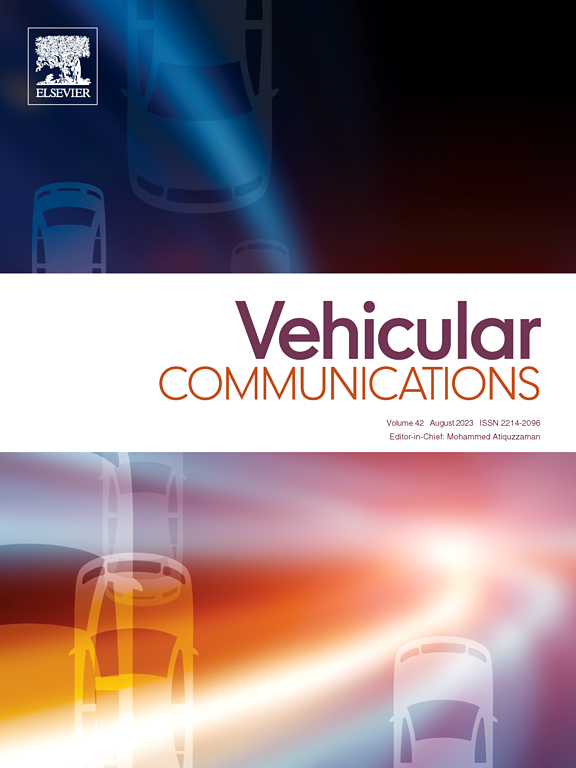Compact 5 G mmWave vivaldi antenna for vehicular communication
IF 6.5
2区 计算机科学
Q1 TELECOMMUNICATIONS
引用次数: 0
Abstract
As a key contribution, this article presents the first successful application of the newly developed Vivaldi Non-uniform Profile Antenna (VNSPA) theory to a Vivaldi Tapered Slot Antenna (VTSA) operating in the 26 GHz band (24.25–27.5 GHz). The proposed design achieves both compactness and simplicity while maintaining high performance. This antenna is a promising candidate for vehicular communication applications, aiming to enhance connectivity, road safety, security, and environmental system control. First, a VTSA with a small volume of 8.1 × 8.3 × 0.813 mm3 is designed, fabricated, and tested, providing S11 value < -11.34 dB at 15.96–28.41 GHz and a maximum realized gain of 6 dBi. Second, a 33 % size reduction of its tapered slot profile (TSP) is obtained by applying the VNSPA theory, resulting in the Vivaldi Non-uniform Slot Antenna (VNSA). Based on this theory, two different non-uniform slot profiles (NSPs) are obtained for VNSA 1 and 2 with final 37 % and 32.55 % volume reduction, respectively, based on parametric studies. VNSA 1 and 2 provide S11 values < -11.6 dB and < -14.3 dB at 16.71 to 27.68 GHz and 17.94 to 27.38 GHz with peak realized gains of 4.6 dBi and 5.15 dBi, respectively. Another key contribution of this research is the on-vehicle analysis of the proposed antenna's applicability for communication. This includes testing the antenna in various positions and demonstrating its capability to radiate in multiple directions, enabling effective communication with other vehicles, pedestrians, roadside units, and mobile networks. Another significant aspect of this research is the calculation of specific absorption rate (SAR), which addresses the effects of electromagnetic radiation on the driver, one back-seat passenger, and pedestrians. The Computer Simulation Technology (CST) software is used to carry out the simulation.
用于车载通信的紧凑型5g毫米波vivaldi天线
作为一项重要贡献,本文首次成功地将新开发的维瓦尔第非均匀轮廓天线(VNSPA)理论应用于工作在26 GHz频段(24.25-27.5 GHz)的维瓦尔第锥形槽天线(VTSA)。提出的设计在保持高性能的同时实现了紧凑和简单。这种天线是车辆通信应用的一个很有前途的候选者,旨在增强连接、道路安全、安保和环境系统控制。首先,设计、制造和测试了体积为8.1 × 8.3 × 0.813 mm3的VTSA,提供了S11值<;-11.34 dB, 15.96-28.41 GHz,最大实现增益为6dbi。其次,通过应用VNSPA理论,将其锥形槽形(TSP)的尺寸减小了33%,从而产生了维瓦尔第非均匀槽形天线(VNSA)。基于这一理论,基于参数化研究,得到了VNSA 1和VNSA 2两种不同的非均匀槽型(NSPs),最终体积分别减小了37%和32.55%。VNSA 1和2提供S11值<;-11.6 dB和<;-14.3 dB,分别为16.71 ~ 27.68 GHz和17.94 ~ 27.38 GHz,峰值实现增益分别为4.6 dBi和5.15 dBi。本研究的另一个关键贡献是对所提出的天线通信适用性的车载分析。这包括在不同位置测试天线,并展示其向多个方向辐射的能力,从而实现与其他车辆、行人、路边设备和移动网络的有效通信。本研究的另一个重要方面是计算特定吸收率(SAR),它解决了电磁辐射对驾驶员,后座乘客和行人的影响。采用计算机仿真技术(CST)软件进行仿真。
本文章由计算机程序翻译,如有差异,请以英文原文为准。
求助全文
约1分钟内获得全文
求助全文
来源期刊

Vehicular Communications
Engineering-Electrical and Electronic Engineering
CiteScore
12.70
自引率
10.40%
发文量
88
审稿时长
62 days
期刊介绍:
Vehicular communications is a growing area of communications between vehicles and including roadside communication infrastructure. Advances in wireless communications are making possible sharing of information through real time communications between vehicles and infrastructure. This has led to applications to increase safety of vehicles and communication between passengers and the Internet. Standardization efforts on vehicular communication are also underway to make vehicular transportation safer, greener and easier.
The aim of the journal is to publish high quality peer–reviewed papers in the area of vehicular communications. The scope encompasses all types of communications involving vehicles, including vehicle–to–vehicle and vehicle–to–infrastructure. The scope includes (but not limited to) the following topics related to vehicular communications:
Vehicle to vehicle and vehicle to infrastructure communications
Channel modelling, modulating and coding
Congestion Control and scalability issues
Protocol design, testing and verification
Routing in vehicular networks
Security issues and countermeasures
Deployment and field testing
Reducing energy consumption and enhancing safety of vehicles
Wireless in–car networks
Data collection and dissemination methods
Mobility and handover issues
Safety and driver assistance applications
UAV
Underwater communications
Autonomous cooperative driving
Social networks
Internet of vehicles
Standardization of protocols.
 求助内容:
求助内容: 应助结果提醒方式:
应助结果提醒方式:


